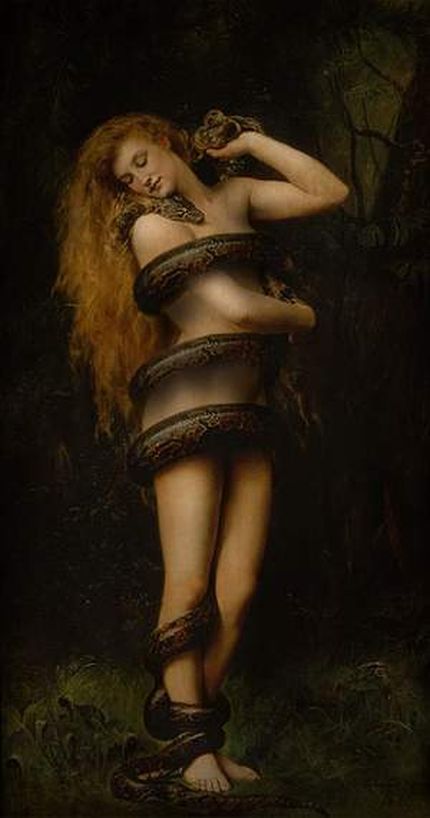Lilith ⚸ - astrology, mythology, art
Lilith in Astrology ★
According to astrology, Lilith is nothing but the shadow of oneself, a pure center of energy, representing the dignity of women. It is that irrepressible force that leads a woman to choose to be herself, whatever the price to pay.
In cartomancy and astrology Lilith indicates the Black Moon. To be precise, Lilith and Black Moon have the same symbolic meaning, relating to the unconscious and rebellious power of female emancipation. Although considered by some astrologers to be synonymous, the Black Moon should indicate one of the two foci of the lunar orbit (the other one is occupied by the Earth); while Lilith in antiquity was considered an alleged second satellite of the Earth (which the ancient Egyptians called Nephthys).
Myths about Lilith ★
An ancient legend tells that Adam's first wife was Lilith, created from the same substance of the man and born with him. "God created man in his image, in the image of God he created them, male and female he created them" (Genesis, 1:27; 10).
The myth of Lilith is already present in the ancient Mesopotamian and Jewish religions, even before the Old Testament. Her story says that she preferred to flee from the Earthly Paradise rather than submit to the will of God and Adam. She did not want to lie under her partner in a physical and symbolic sense, and so she left. In "The alphabet of Ben-sira" (by an anonymous author, written in the 10th century AD) we can read: "She said 'I will not stand under you,' and he said 'And I will not lie under you, but only on you. It is suitable for you to be only below, while I am made to be above." Enraged, Lilith spoke the name of God, took flight and fled the garden of Eden, taking refuge on the shores of the Red Sea. Having not touched the Tree of Knowledge, she was not condemned to mortality.
The medieval culture then transformed the figure of Lilith into a sort of a demon, of an evil and tempting being, of a totally wrong female example and from which all would have to take distance.
Ancient legends narrate that Lilith (like Lamia, another goddess who became a demoness) stole children and killed them. The myth that precedes her demonization, on the other hand, recalls her as the protector of pregnant women, invoked to protect pregnant women.
It doesn't take long to identify in the myth of Lilith a man's fear of a woman who does not conform to his rules. Lilith echoes all the masculine fears for a woman who says "no", who does not allow herself to be tamed and who follows her feral nature.
Someone insinuates that the tempting snake of Genesis was Lilith (in some representations of her we can see her with a snake's tail or with rapacious claws).
Lilith through art ★
Lilith was represented by various artists, here we can see some symbolic paintings about her, that clearly reflect the myths about her figure.
 |
| Lilith, by John Collier (1889), oil on canvas, Atkinson Art Gallery in Southport, England |
 |
| Lady Lilith, by Dante Gabriel Rossetti (1873), oil on canvas, Delaware Art Museum, Wilmington, Delaware |
 |
| Faust and Lilith, by Richard Westall (1831), London Royal Academy, England |
★For more about astrology follow me on instagram @ebla.astrology ★
Sources:
(1) Simona Vitale - Il mito perduto di Lilith - (http://www.antikitera.net/news.asp?id=13623&T=4)
(2) Anna Laura Cannamela Embergher - Il mito ebraico di Lilith - (http://www.labrys.it/lilith.html)
(3) Giulia Lionetto Civa - Lilith la prima moglie di Adamo - (http://www.zipgiovani.it/lilith,-la-prima-moglie-di-adamo...-ed-eva-.html)
(4)Wikipedia - (https://it.wikipedia.org/wiki/Lilith)
Comments
Post a Comment